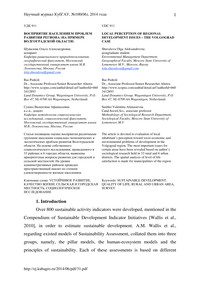11.00.00 ГЕОГРАФИЧЕСКИЕ НАУКИ
Покупка
Основная коллекция
Издательство:
Кубанский государственный аграрный университет
Год издания: 2014
Кол-во страниц: 18
Дополнительно
ГРНТИ:
Скопировать запись
Фрагмент текстового слоя документа размещен для индексирующих роботов
Научный журнал КубГАУ, №100(06), 2014 года http://ej.kubagro.ru/2014/06/pdf/31.pdf 1 УДК 911 ВОСПРИЯТИЕ НАСЕЛЕНИЕМ ПРОБЛЕМ РАЗВИТИЯ РЕГИОНА (НА ПРИМЕРЕ ВОЛГОГРАДСКОЙ ОБЛАСТИ) Шувалова Ольга Александровна аспирант Кафедра рационального природопользования, географический факультет, Московский государственный университет имени М.В. Ломоносова, Москва, Россия lola.shuvalova@gmail.com Bas Pedroli Dr., Associate Professor/Senior Researcher Alterra http://www.scopus.com/authid/detail.url?authorId=660 3412893 Land Dynamics Group, Wageningen University, P.O. Box 47, NL-6700 AA Wageningen, Netherlands Сушко Валентина Афанасьевна к.с.н., доцент Кафедра методологии социологических исследований, социологический факультет, Московский государственный университет имени М.В. Ломоносова, Москва, Россия Статья посвящена оценке восприятия различными группами населения социально-экономических и экологических проблем развития Волгоградской области. На основе собственного социологического исследования, проведенного в 33 районах и 6 городах области, выявлены приоритетные вопросы развития для городской и сельской местностей. На уровне административных районов проведен пространственный анализ по степени удовлетворенности жизнью населением Ключевые слова: УСТОЙЧИВОЕ РАЗВИТИЕ, КАЧЕСТВО ЖИЗНИ, СЕЛЬСКАЯ И ГОРОДСКАЯ МЕСТНОСТЬ, СОЦИОЛОГИЧЕСКОЕ ИССЛЕДОВАНИЕ UDC 911 LOCAL PERCEPTION OF REGIONAL DEVELOPMENT ISSUES – THE VOLGOGRAD CASE Shuvalova Olga Aleksandrovna postgraduate student Environmental Management Department, Geographical Faculty, Moscow State University of Lomonosov M.V., Moscow, Russia lola.shuvalova@gmail.com Bas Pedroli Dr., Associate Professor/Senior Researcher Alterra http://www.scopus.com/authid/detail.url?authorId=660 3412893 Land Dynamics Group, Wageningen University, P.O. Box 47, NL-6700 AA Wageningen, Netherlands Sushko Valentina Afanasievna Cand.Sociol.Sci., associate professor Methodology of Sociological Research Department, Sociological Faculty, Moscow State University of Lomonosov M.V The article is devoted to evaluation of local inhabitant’s perception toward socio-economic and environmental problems of development in the Volgograd region. The most important issues for certain areas have been revealed based on author’s sociological research held in 33 rural and 6 urban districts. The spatial analysis of level of life satisfaction is made for municipalities of the region Keywords: SUSTAINABLE DEVELOPMENT, QUALITY OF LIFE, RURAL AND URBAN AREA, SURVEY 1. Introduction Over 800 sustainable activity indicators were developed, mentioned in the Compendium of Sustainable Development Indicator Initiatives [Wallis et al., 2010], in order to estimate sustainable development. A.M. Wallis et al., regarding existed models of Sustainability Assessment, collated them into three groups, namely, the pillar models, the human-ecosystem models and the principles of sustainability. Each of these assessments is based on different
Научный журнал КубГАУ, №100(06), 2014 года http://ej.kubagro.ru/2014/06/pdf/31.pdf 2 approaches. Human – ecosystem models grounded on the carrying capacity concept, which assumed that there are limitations to human influence on the environment. In the second method, indicators are chosen according to the principles of sustainability. The pillar models come from the early first definition of the concept of sustainable development, which was described in a report of the Brundtland Commission «Our common future» and defined as a development that meets the needs of the present without compromising the ability of future generations to meet their own need. There has been considered the two-pillar approach of environment and development. Since that time numerous modifications have been made to the interpretation of the concept and the current milestone is the three-bottom or three-pilar model that takes into account environmental, social and economic parts of development. According to Pope [Pope et al., 2004], sustainability is a multidimensional concept, where all the aspects must be considered and integrated. The scope of sustainable development practices encompass a broad range of parameters considering facets of the concept, but complementary bottom-up approach taking into account local citizens’ awareness, demands and attitudes are still absent. Relatively few studies touch community participation in defining concept, indicators, and goals for sustainability. Thus, Valentin and Spangenberg [Valentin, Spangenberg, 2000] hold the view of community participation in selecting indicators, which should be simple and relevant. The relevance can be defined from strategic policy documents, but vitally in accord with public opinion. Kain [Kain, 2000] described a prism of sustainable development in which one of the facets is mind as a social dimension of awareness of individual subject, forms of their knowledge, views and experiences. The Research Institute Ambiente Italia in a frame of the project ECI (European Common Indicators) developed a list of ten indicators, which represented answers of respondents [Tarzia, 2003]. A.M.Wallis together with his colleagues (2011) analysed models that had been used for developing


